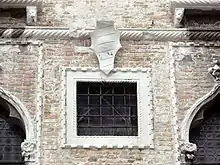Palazzo Pesaro Orfei
The Palazzo Pesaro Orfei or Palazzo Pesaro degli Orfei is a historic palace in Venice, in northern Italy. It was built by the Pesaro family in the fifteenth century in Venetian Gothic style.[2] From 1902 it was the home of Mariano Fortuny and his wife Henriette Negrin.[3]: 49 It now houses the Museo Fortuny, and may also be called Palazzo Fortuny.
| Palazzo Pesaro Orfei | |
|---|---|
 Façade of the palace on Campo San Beneto | |
| Alternative names |
|
| General information | |
| Architectural style | Venetian Gothic |
| Location | Campo San Beneto, Venice |
| Country | Italy |
| Coordinates | 45.4354°N 12.3322°E |
| Current tenants | Museo Fortuny |

History
The palace is in the sestiere of San Marco, in the centre of the city, and lies between the Campo San Beneto and the Rio di Ca' Michiel. It has a façade onto each, while the northern façade is on the Calle Pesaro.[3]: 49 [1]: 494
It was built in the fifteenth century by Benedetto Pesaro, member of the prominent Pesaro family, and is one of several palaces of that family in the city.[2][4][lower-alpha 1] The San Beneto branch of the family died out towards the end of the seventeenth century, and from about 1720 the palace was let to various tenants, among them a printer – the Tipografia Albrizzi – and two musical associations, first the Accademia degli Orfei from 1786 and then, from 1835, the Società Apollinea.[4][5]: 189 For most of the nineteenth century the building was subdivided and let to various artisans. By the time Mariano Fortuny established his first Venetian studio there, in the last years of the century, there were some 350 tenants.[3]: 49 [4][6]: 6 He gradually bought up space, demolishing the later dividing walls and restoring the rooms bit by bit to their earlier form; in 1902 he made it his home.[3]: 49 In 1907, together with his future wife Henriette Negrin, he established a small workshop; within a few years, two floors of the palace were devoted to the printing of silk and velvet clothing and textiles.[4]
Fortuny died in 1949, and in 1956 the palace was gifted to the comune of Venice; the comune took full possession only in 1965, after the death of Fortuny's widow Henriette. The Museo Fortuny was opened in 1975.[4][6]: 6
Notes
- Others include Ca' Pesaro, Palazzo Pesaro Papafava, Palazzo Ravà, and probably the Fondaco dei Turchi.[2]
References
- Marcello Brusegan (2005). La grande guida dei monumenti di Venezia: storia, arte, segreti, leggende, curiosità (in Italian). Roma: Newton & Compton. ISBN 9788854104754.
- Mario Brunetti (1935). Pesaro (in Italian). Enciclopedia Italiana. Roma: Istituto dell’Enciclopedia Italiana. Accessed September 2018.
- A.S. Byatt (2016). Peacock & Vine: Fortuny and Morris in life and at work. London: Chatto & Windus. ISBN 9781784740801.
- Palazzo Fortuny: Museo: La sede e la storia (in Italian). Fondazione Musei Civici di Venezia. Accessed September 2018.
- Gianjacopo Fontana (1967). Venezia monumentale: I palazzi (in Italian). Venezia: Filippi.
- Alessandro Maggiore, Walter Hartsarich, Daniela Ferretti (2013). La facciata di Palazzo Fortuny – Racconto di un restauro (in Italian). Venice: Comune di Venezia; Fondazione Musei Civici di Venezia; Sovrintendenza per i Beni Architettonici e Paesaggistici di Venezia e Laguna.